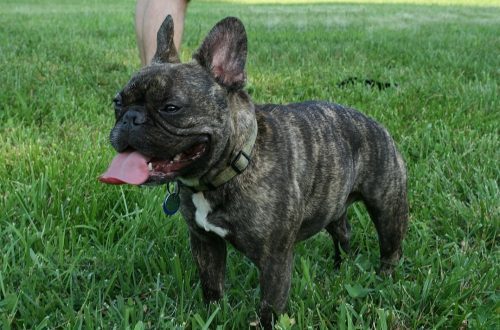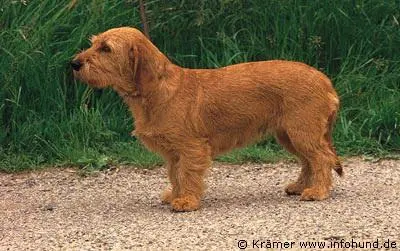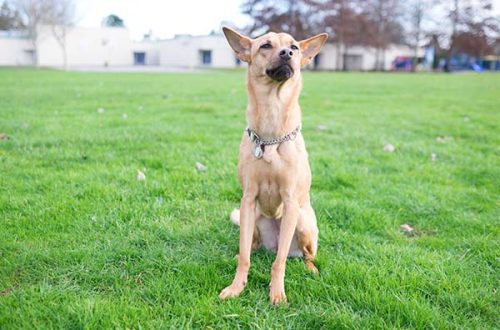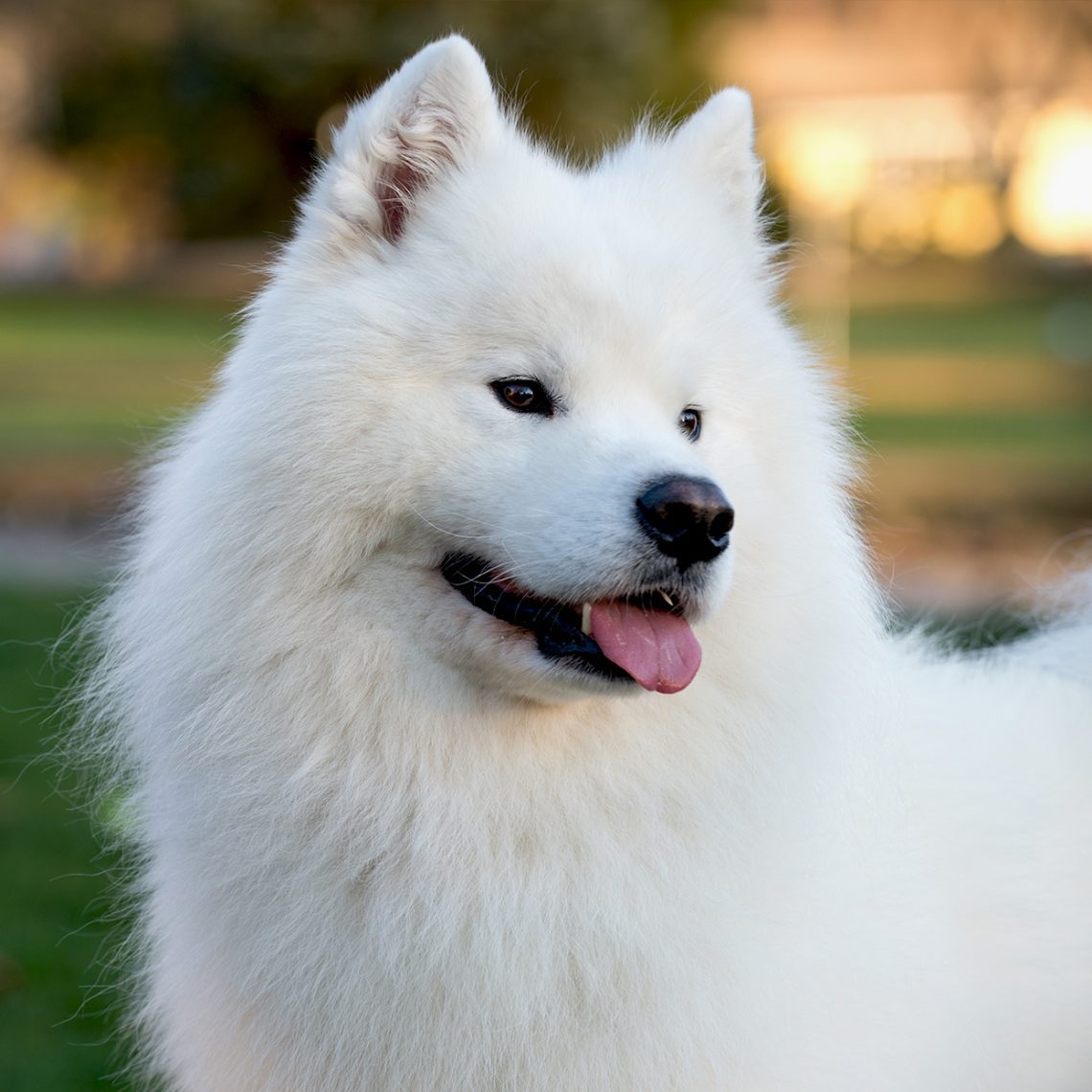
Samoyed Dog
Other names: Samoyed , Samoyed Laika , Arctic Spitz
The Samoyed dog is a friendly, loyal animal that combines the best features of a companion for active leisure and a playful family pet.
Contents
- Characteristics of Samoyed Dog
- Basic moments
- History of the Samoyed dog breed
- Video: Samoyed
- Samoyed Appearance
- Photo of adult Samoyeds
- The nature of the Samoyed dog
- Education and training
- Care and maintenance
- Health and disease of the Samoyed dog
- How to choose a puppy of Samoyed Dog
- Photo of Samoyed puppies
- How much does a samoyed cost
Characteristics of Samoyed Dog
| Country of origin | Russia |
| The size | large |
| Growth | 46-56 cm at the withers |
| Weight | 20–28 kg |
| Age | 10–12 years old |
| FCI breed group | spitz and primitive breeds |
Basic moments
- The Samoyed is a primitive breed. This means that there was practically no human intervention in the selection, which is why the dogs are distinguished by enviable health.
- The Arctic Spitz is an animal accustomed to living in a pack and obeying its laws. This must be taken into account when building a relationship with a pet.
- The Samoyed dog is distinguished by a complaisant character, mobility, courage, and a friendly attitude towards people and other animals.
- Samoyeds do not tolerate loneliness well. This breed is not suitable for use as a yard or chain breed.
- Pamper your pet with fish – unlike other dogs, Samoyeds are very fond of seafood.
- The snow-white fur coat of the animal, contrary to popular belief, does not require frequent bath procedures.
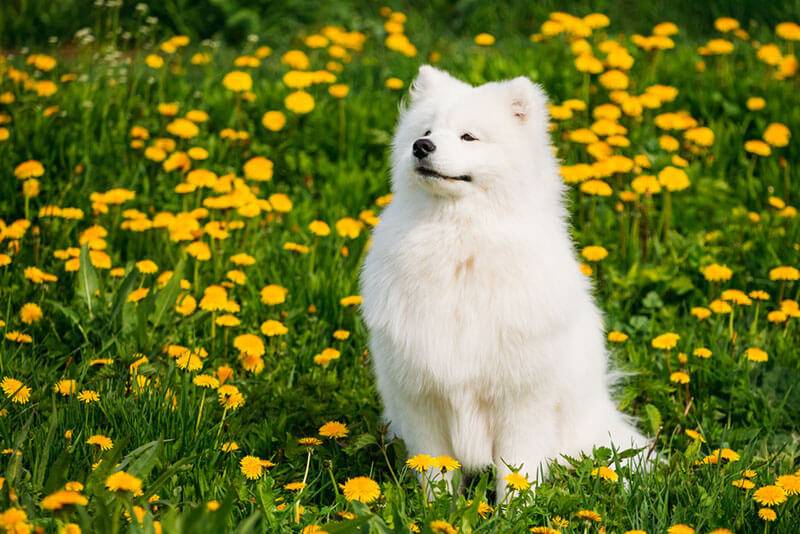
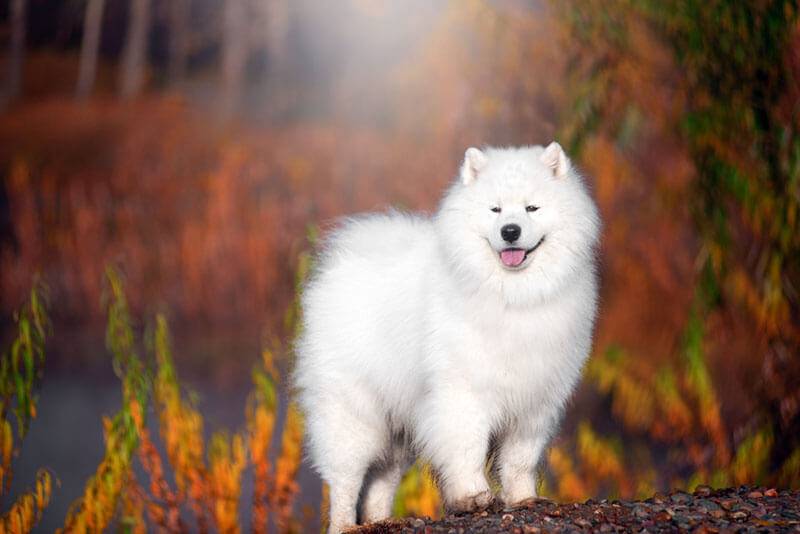
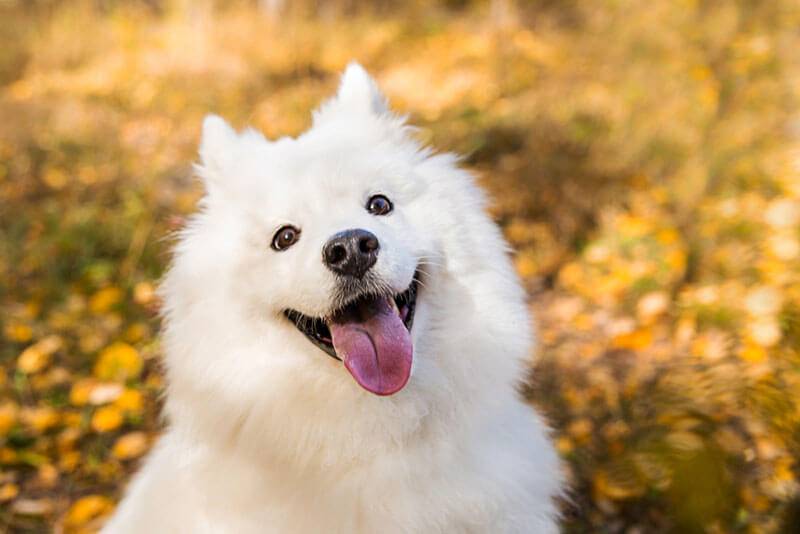
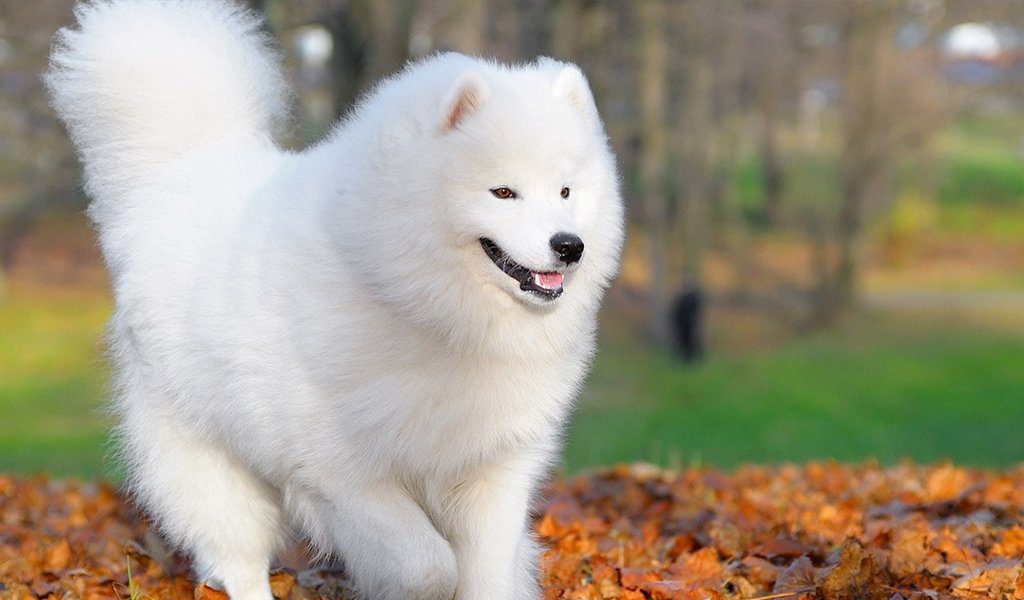
The Samoyed dog not only has a magnificent appearance, but also has an enviable intellect, an excellent complaisant character, and selflessness. In conditions of high latitudes, it has served man faithfully for many centuries. The harsh conditions of the north impose special requirements on a dog living next to a person. Protecting reindeer herds, hunting for wild animals, working in a team, and practically any kind of activity in the Arctic is impossible to imagine without the participation of trained huskies. These animals are highly valued in the conditions of the “civilized” world.
The Samoyed is a very interesting breed. It is so unusual that even the names Samoyed Laika or Arctic Spitz used in the scientific community cannot fully reflect all of its characteristic features. Gorgeous thick fluffy white coat with soft undercoat and stiffer outer hair (typical polar explorer), slanted, very intelligent, even with some cunning eyes and an all-encompassing love for all living things, which manifests itself every minute – these are the integral features of this magnificent representative of the canine family. Maximum attention, admiration and delight are guaranteed to any owner of an inimitable Samoyed!
History of the Samoyed dog breed
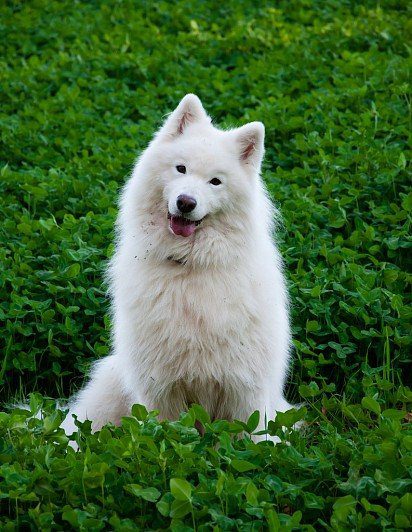
Researchers believe that Samoyed huskies have been living next to humans for about three thousand years, and in an almost unchanged form, since their habitat is limited, and mixing with other dogs was impossible for objective reasons.
The breed got its name from the name of the nomadic tribes of the northern regions of the Urals and Siberia, now known as the Nenets. These peoples lived apart from the outside world and were self-sufficient, “self-unified” – hence the name. There is no need to look for any “gastronomic” subtext in the word “Samoyed”.
From these regions, in the late 19th century, the British zoologist and dog lover Ernst Kilburn-Scott brought several remarkable dogs to London. Among them was a very large snow-white male named Masti. It was from this period that the modern history of the breed began. In 1909, Scott and his wife opened the Farmingham kennel, which is still famous to this day, and a couple of years later, the first club for lovers of unusual northern dogs appeared. At the same time, a standard was defined that has existed unchanged for more than a hundred years. The breed quickly gained wide popularity, and already in the thirties of the last century, kennels for breeding Samoyeds appeared in continental Europe. Such attention of breeders to the preservation of the species has played a positive role. The fact is that the development of civilization has led to irreversible consequences: even in the original habitat, in the Far North, it is very problematic to meet a purebred Samoyed native. In its original form, the breed was preserved in Western nurseries, from where it began its return to its historical homeland – to Russia. To date, the number of Samoyeds in our country is 2-3 thousand individuals.
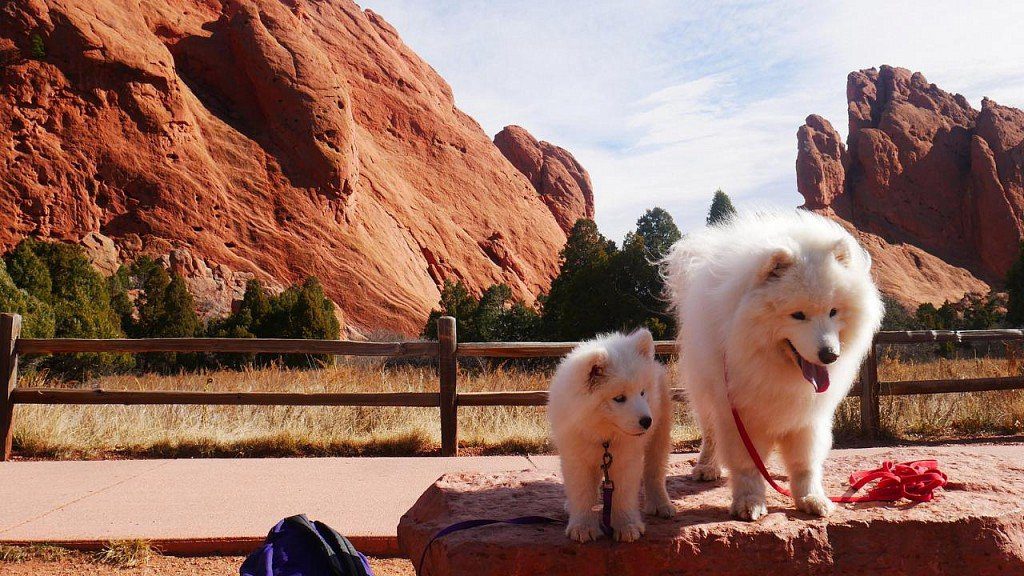
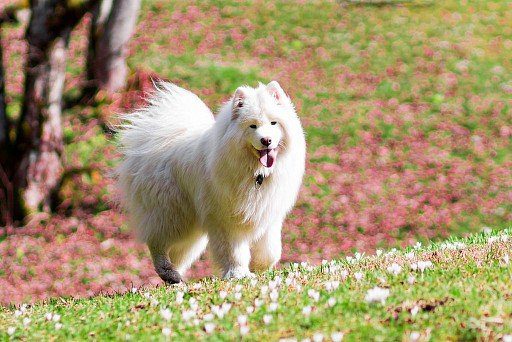

Video: Samoyed
Samoyed Appearance
There are two main varieties of the breed – wolf and bear Samoyed. Small differences are observed in the external structure of the trunk and head. The first type is characterized by a slightly more elongated body and a relatively narrow skull, while the second type, on the contrary, has a shortened powerful body and a wide head.
The English Kennel Club in 1988 defined the following breed standard “Samoyed dog”.
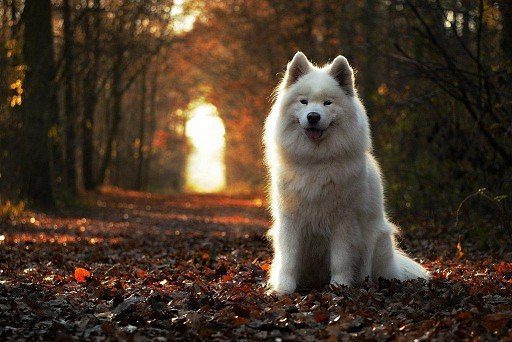
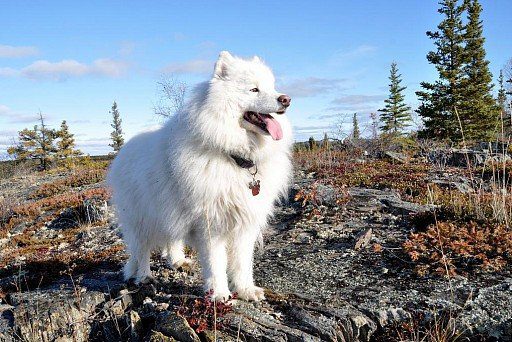
General appearance
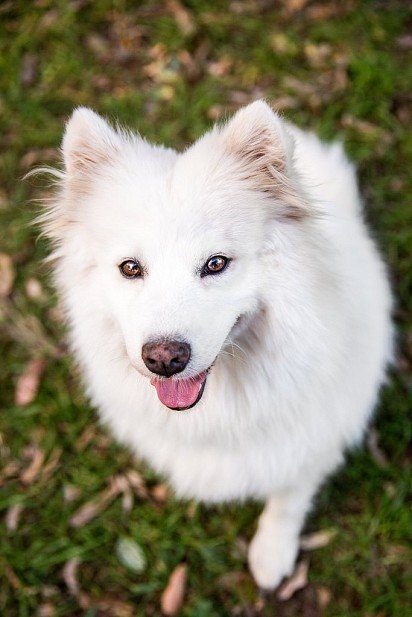
Harmoniously built dog of medium size. The growth of males at the withers is 54-60 cm, females are 50-54 cm. The average weight of a Samoyed is from 20 to 30 kg (depending on gender). The movements are distinguished by activity, accentuated by a strong push.
Samoyed Dog Wool
Samoyed husky is the owner of a very thick and fluffy “Arctic” fur. There is a soft, short, almost downy undercoat and a long, straight outer coat. Representatives of the breed are characterized by the presence of a “collar” around the shoulders and neck. The head and forelimbs are covered with even short hair, the back of the thigh is covered with “trousers”. Between the toes of the paws, the presence of a protective hairline is mandatory.
Color
Pure white, white with hints of pale biscuit or pale cream. The tips of the guard hairs are silver, which creates the effect of a “sparkling” coat.
Samoyed Dog Head
The skull of the Samoyed is wedge-shaped, powerful. The distance between the ears is wide, the hair in this area is short and smooth. The muzzle is of medium length, gradually tapering. Lips – black, with a characteristic “smile”. The eyes are almond-shaped, dark brown in color with a black rim, set wide apart. The nose is black, with a well developed lobe. Other nose pigmentation (meat-colored or brown) is allowed, but black edging must be visible in any case. The ears are of medium length, slightly rounded at the tips, covered with thick hair from the inside, in adult Samoyeds they are always upright. Sufficiently powerful, but not square jaws. A scissor bite is considered ideal. The head is set on a strong neck of medium length with a noble bend.
torso
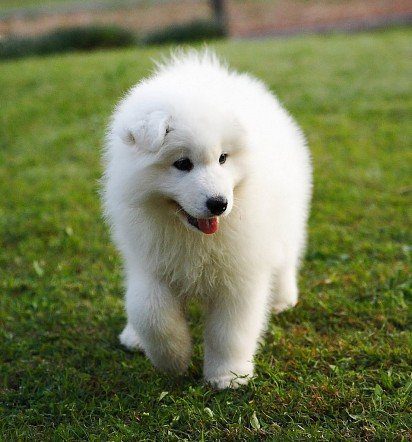
The back is muscular, straight, slightly longer in females than in males. Strong, well-defined loin, merging into a strong, slightly sloping croup. The chest is long, powerful and deep.
Samoyed Dog limbs
The forelegs are of medium length, parallel and straight, with the elbows close to the body. The paw is oval with long, not too pressed to each other fingers. The hind legs are very muscular, straight and parallel. The hock joint is located rather low, the articulation angles are clearly visible on it. The shape of the paws is the same as on the forelimbs.
Tail
Quite long, very well pubescent. When moving and in an excited state, it is located above the back, twists straight or sideways. The tail in the form of a ring in Samoyeds is considered a disadvantage. At rest, it can descend to the hocks.
Photo of adult Samoyeds
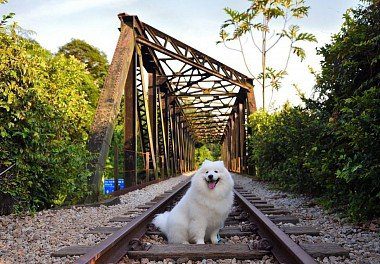
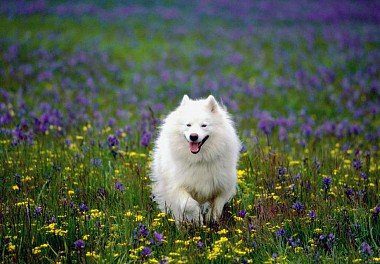
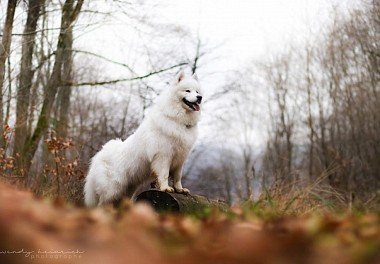
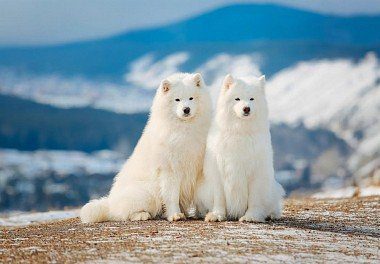
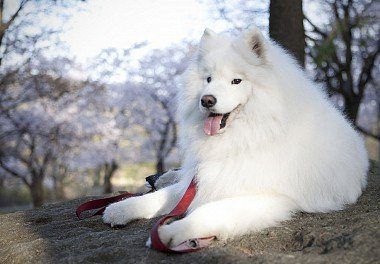
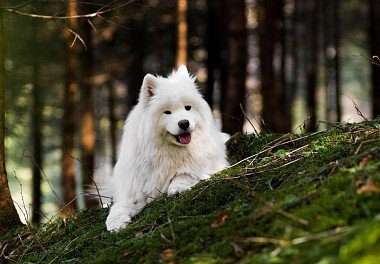
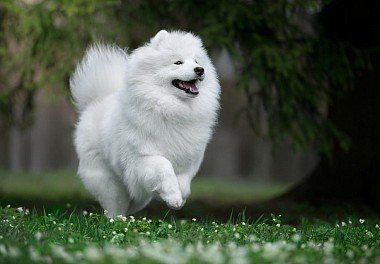
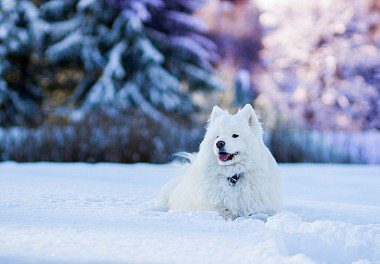
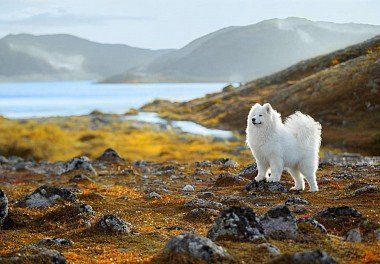
The nature of the Samoyed dog
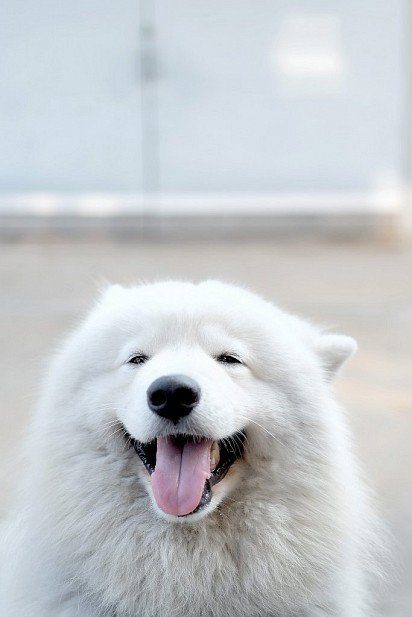
If you are looking for a dog with the perfect temperament, then the Samoyed is the one for you. Representatives of this breed are surprisingly friendly, playful and quick-witted. However, it is impossible to call them phlegmatic and quiet. The spirit of enthusiasm, passion for team work, the need for constant communication, seething energy and at the same time amazing, sometimes even excessive trust in others are the main character traits of the Samoyed. To make the portrait of this northern handsome man more objective, it is worth mentioning his stubbornness, which the owners of these dogs associate with an innate self-esteem. The habit of working in a team and living in close contact with other pets, laid down at the gene level, has practically nullified the tendency to conflict behavior, although you cannot deny the courage of the Samoyed. This character trait is indicative of the breed, and any manifestation of cowardice or aggressiveness is considered a serious fault. For the same reason, you should not count on the Samoyed as a guard dog. Distrust and wariness may be the only behavioral responses towards a stranger.
The Arctic Spitz hunter, contrary to his historical past, is also very mediocre. Of course, he will not refuse to drive a neighbor’s cat up a tree, but he will definitely not understand and share your passion for hunting. Another thing is active games and competitions. This is where his energy kicks in. Favorite activity is driving. Even the opportunity to just ride your children on a sled will be the best reward for a dog.
The Samoyed is a dog that needs constant contact with its “pack” (and your family is one for it). Loneliness just hurts these beauties. Many owners noted in their pets even manifestations of what would seem to be such a purely human feeling as fear of an impending separation. Keeping a Samoyed on a chain or locked in an aviary is simply inhumane. As a result of such treatment, the animal may develop permanent mental disorders.
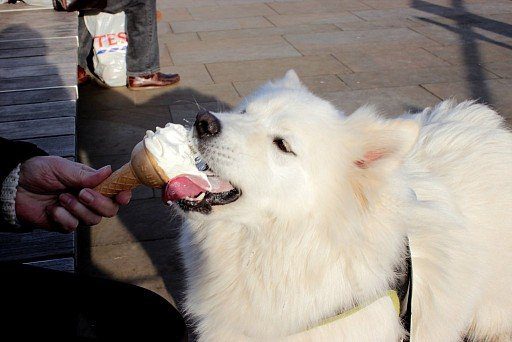
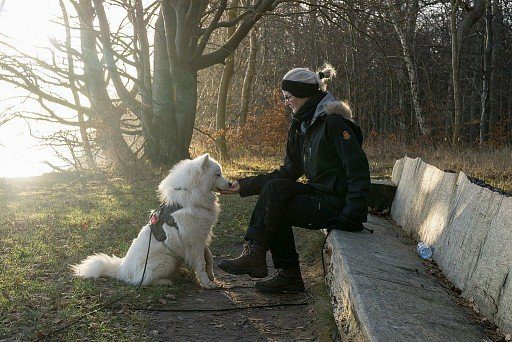
Samoyed dogs get along well with small children, although their overwhelmed feelings can be shown with excessive assertiveness. Samoyed will quickly find contact with your child and will become a wonderful companion and playmate. Arctic Spitz puppies have a restless, even slightly hooligan character, so they simply need constant attention from the owner.
Busy people, rarely at home, this breed is not suitable. It is unlikely that the benefits of a Samoyed dog will be appreciated by calm people who prefer a measured course of life, because the animal loves to bark, and to maintain vitality it needs systematic physical activity. But if you decide to start a Samoyed, be prepared for the fact that the rhythm of your life will change dramatically. And who said it’s not for the best?
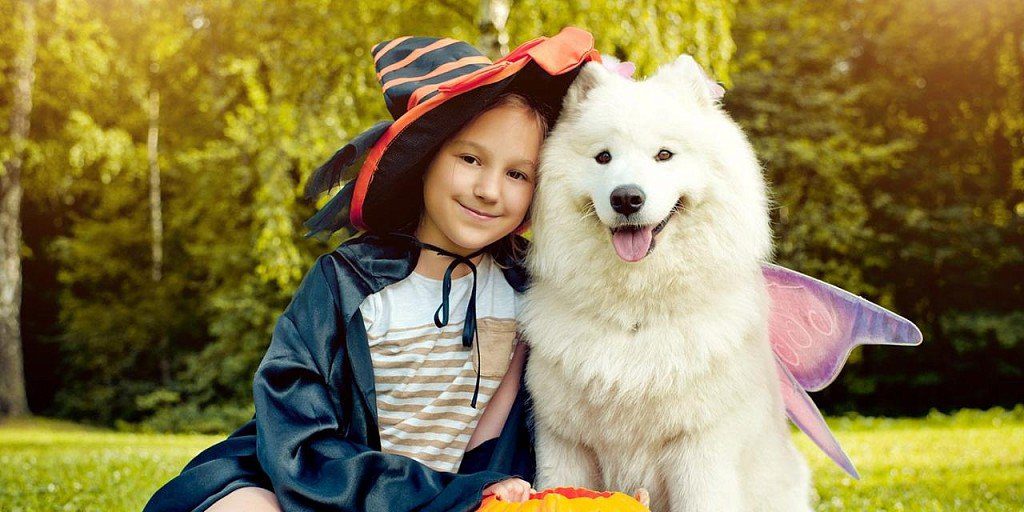
Education and training
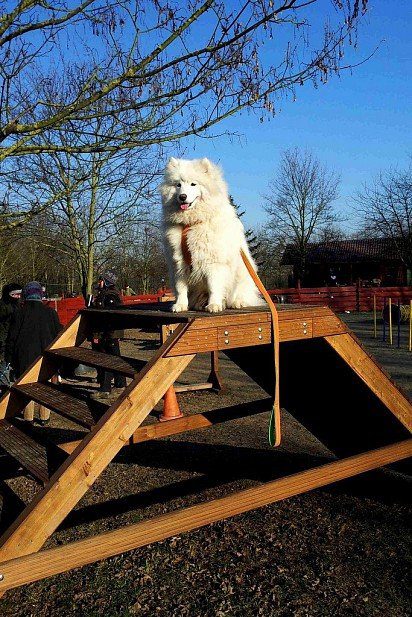
Samoyeds, like any other dogs, lend themselves well enough to training. But the features of the breed left their mark on this process. The main difficulties, paradoxically, arise from the highly developed intelligence of the snow dog. The habit that comes from the depths of centuries to independently learn the world and trust only yourself in this has formed those character traits that many consider a manifestation of stubbornness and independence. In their development, Samoyeds are very dynamic, and the monotony of situations created in the process of training quickly bothers them, becomes uninteresting. By showing originality and originality in the methods of education, you can achieve amazing results.
Pet training should start at an early age. Since the Samoyed is a pack dog, the first thing to do is to make it clear who is in charge in the house. By recognizing your authority as a leader, in the future the puppy will be better able to educate.
Experts recommend starting training a Samoyed puppy from the age of three months. At first, you need to teach your baby to follow the simplest commands. You can cope with this task on your own – you just need to show perseverance and patience. It is better to train a Samoyed dog to perform more complex commands under the guidance of an experienced instructor. He will tell you how to build the training process, based on the temperament and character of your pet.
Training and education of Samoyeds have their own nuances. You must remember that your Samoyed is a pack oriented animal. Understanding the hierarchy, its strict laws is inherent in it at the genetic level, so it is important from the very beginning of the puppy’s stay in your house to clearly and unambiguously make it clear to him who is in charge here. Everything is like in a dog or wolf pack:
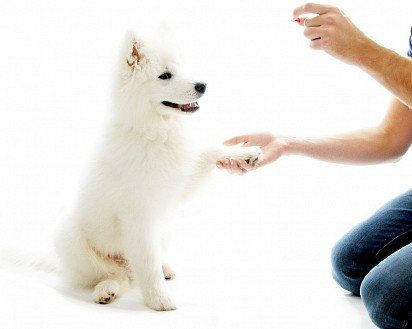
- the elders are the first to start the meal. Give the puppy food only after you get up from the table;
- by right of chief, always enter the house first;
- the affairs of the pack are discussed and decided only by its senior members. Set aside a specific spot for your puppy so he won’t be near you without permission.
The rules are not complicated at all, and, most importantly, their implementation will be taken by your pet as a matter of course.
The path to success in training a Samoyed lies only through love, patience and respect for the animal. Rudeness and violence in communication with the Samoyed Laika is completely unacceptable. It’s not about permissiveness. If the dog is guilty, it must be punished (and this is also the law of the pack). By the right of the elder, simply lift the dog by the withers, shake it slightly and press its muzzle to the floor. You will not hurt him, but make it clear to your pet that he is guilty.
In the end, who will grow out of a cute white puppy of a Samoyed dog will depend only on the owner.
Care and maintenance
When purchasing a Samoyed dog, ask the breeder about how the baby ate. Try to follow the stated diet and feeding schedule as much as possible until the dog gets used to the new environment. Transfer your dog to the planned diet gradually – this will relieve digestive problems.
The owner decides which food – dry or natural – to feed the animal. It is desirable that factory feeds be in the premium category or higher. They contain all the necessary ingredients for normal development in balanced proportions. It is possible to make a complete diet from natural products, but this is associated with additional troubles, for which the owners sometimes simply do not have time.
Even using ready-made food, it is useful to introduce fish dishes into the diet of the growing Samoyed, which he (unlike other dogs) loves very much.
Northern dogs are also happy to eat cottage cheese, which should be part of the daily menu. It is better to give it in the morning and make sure that the fat content of the product does not exceed 18%.
Do not forget to add vitamins for wool and proper bone formation to the diet.
The snow-white luxurious coat of the Samoyed is a special pride of the breed. It does not get wet from snow or rain, and has an amazing ability to self-clean due to the presence of natural oils on it. Frequent bathing can impair this wonderful ability and cause skin or cold problems in your dog. The exception is the paws, which need to be washed after each walk. The frequency of “bathing” procedures for the Samoyed is 1-2 times a year. Show animals bathe more often and only with the use of professional shampoos designed for this type of coat.
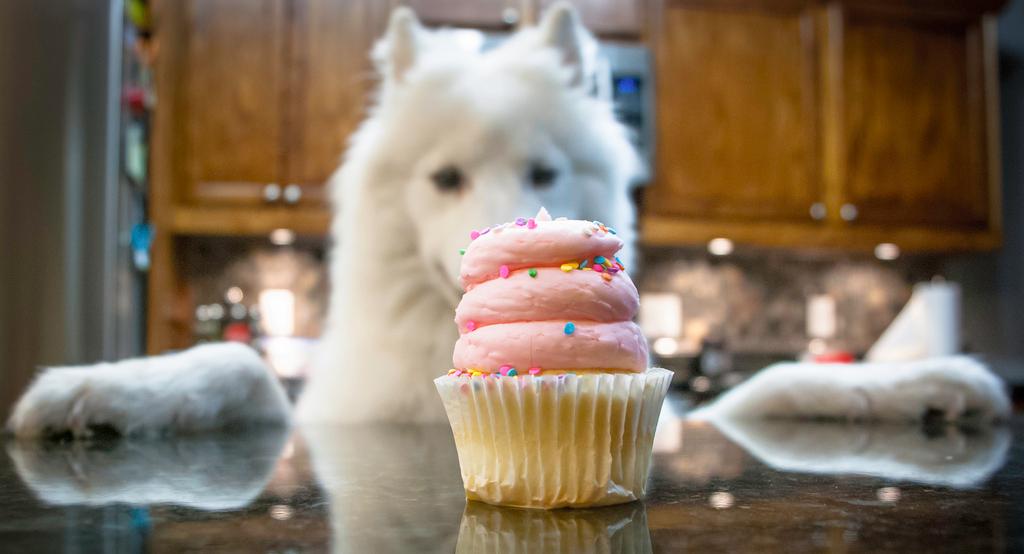
Protect the eyes and ears of the animal from water and detergent. After bathing the pet, dry it with a towel, dry the coat with a hair dryer, while combing it in the opposite direction to its growth.
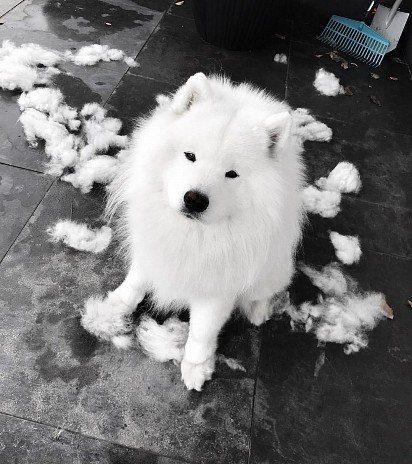
Shedding a dog will not cause you such troubles that at first glance it would be logical to assume. Bitches shed twice a year, males only once. The process lasts no more than two weeks, the rest of the time the Samoyed dog does not lose hair at all. Systematic combing with special combs will reduce the molting time. Another indisputable advantage of the wool of the Arctic Spitz is that it has no smell.
The coat of a snow dog has excellent thermal insulation abilities, so Samoyeds tolerate not only extreme cold, but also heat. The only thing that absolutely cannot be done is to walk your pet under the scorching rays of the sun.
The size of the animal is not a problem for keeping in a city apartment. Determine a permanent place for the Samoyed in a cooler part of your home. The bedding should not be soft and kept clean. It is desirable that from its place the Samoyed husky could control all the events taking place in the house: as a member of the pack, she must be aware of what is happening.
Dental care consists of weekly brushing with a special toothpaste. Ears once a month are recommended to be wiped with a dry soft cloth. The claws of Samoyed dogs are not cut – they grind off during walks.
You need to walk with your pet at least twice a day, the duration of each exercise is at least an hour. If possible, devote as much time as possible to physical activity and active games on weekends.
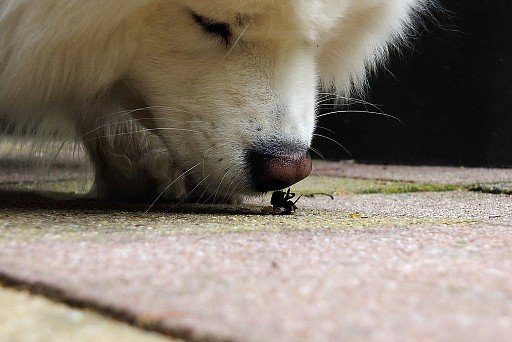
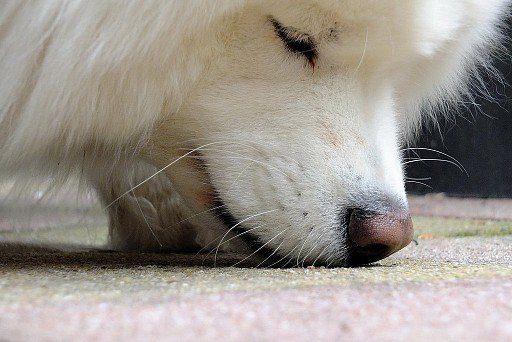
Health and disease of the Samoyed dog
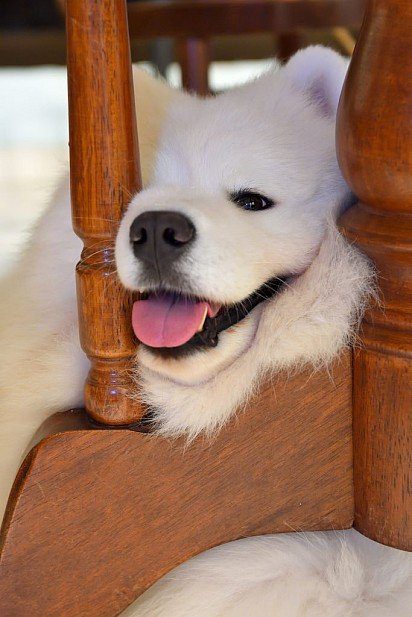
The Samoyed husky belongs to the so-called primitive dog breeds, since human intervention in its formation and development is extremely insignificant. The breed is distinguished by good health, however, due to the northern origin, the threshold for resistance to infectious diseases in the Samoyed is low. The only effective way to avoid infection with serious diseases (plague, viral hepatitis, parovirus enteritis, rabies) is timely vaccination. The first vaccinations should be given by the breeder to one month old puppies. Revaccination is carried out in several stages: at two, at three months, after the change of teeth and when the dog reaches one year of age. Further, a comprehensive vaccination is given annually.
Like any other breed, the Samoyed dog has hereditary diseases. The most common is hip dysplasia. If you begin to notice your pet has problems associated with motor activity, contact your veterinarian immediately. Modern methods of treatment with timely treatment give a good therapeutic effect. Other genetic problems include congenital deafness, as well as some eye pathologies.
Samoyeds sometimes suffer from bloating. Preventive measures in this case are reduced to compliance with the feeding regimen and control over its quality. Do not give your animal raw dough, sharp bones, or other foods that may cause digestive disturbances. Never take your dog for a walk immediately after feeding!
Fleas and ticks, which can be carriers of severe, sometimes fatal diseases, bother Arctic Spitz. In this case, special (preferably fabric) insecticidal collars will help you. They will not spoil the appearance of wool (unlike drops), but they will get rid of insects.
Pay close attention to the health and behavior of your dog. Seeing your veterinarian early can help keep your pet healthy and happy.
How to choose a puppy of Samoyed Dog
Before purchasing a Samoyed, decide for what purpose you want to have this miracle of nature in your house.
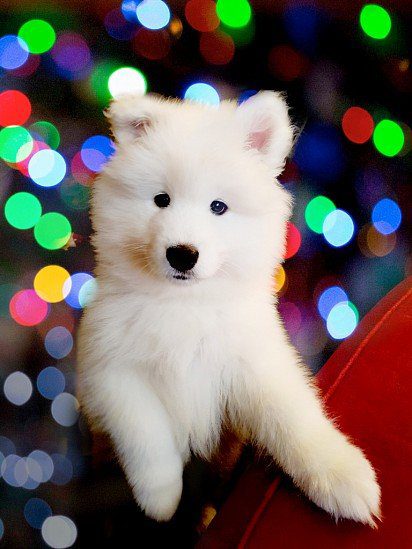
- Samoyed companion. A dog for a family home is selected according to its character and temperament. Puppies (even from the same litter) vary greatly in character. There are clear leaders and quiet ones, there are inquisitive and restless ones, and there are balanced and calm ones. But the Samoyed baby should in no case be aggressive and cowardly. Watch your chosen one for some time, if the breeder gives you such an opportunity. Do not hesitate to ask questions about the baby’s parents: what is their character and behavior, how old are they, whether hereditary diseases have manifested themselves in the foreseeable past. As for gender, observations show that Samoyed boys often show leadership qualities, independence and stubbornness, and girls will charm you with their affectionateness, the ability to subtly feel the mood of the owner.
- Samoyed champion. These are puppies of the so-called show class, the elite of the breed. The cost of such a dog is very high, so it is better to turn to experts for help in choosing – only they can predict the show prospects of each puppy from the litter with a high degree of accuracy. Be sure to ask about the pedigree – it’s good if champion dogs appear in the ancestors. You can’t buy a show class puppy right away. As a rule, offspring from promising pairs of Samoyeds sign in advance. Take note of this moment!
- Samoyed for work. Such puppies are bought as sled dogs to participate in various kinds of sports competitions in the future. The parents of such puppies (or at least one of them) must be working dogs themselves. There are very few such pairs of northern huskies in Russia, so it can take a very long time to wait for a suitable baby.
A thoroughbred puppy of a Samoyed dog is necessarily stigmatized. The mark is placed on the ear or groin. Check that the actual stigma matches the one indicated in the metric and in the veterinary passport.
The animal passport must contain all information about the vaccinations performed with the signature of the doctor and the seal of the veterinary clinic, also pay attention that the page on anthelmintic procedures is filled out and signed.
Photo of Samoyed puppies
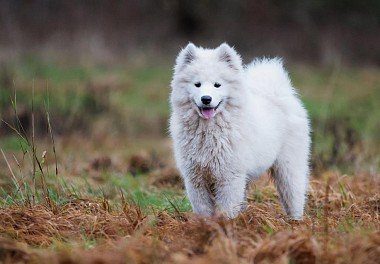
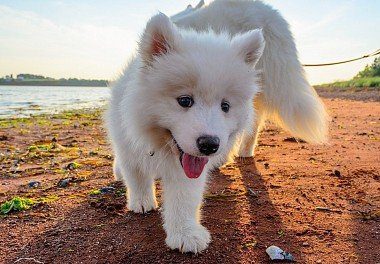
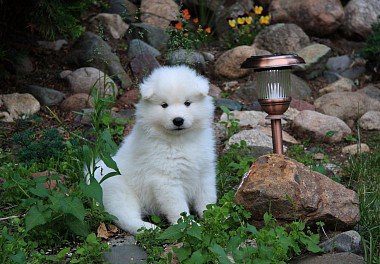
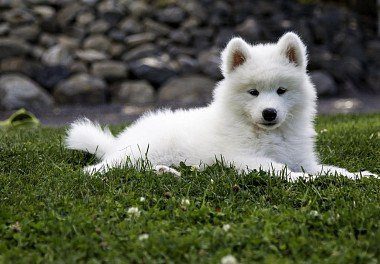
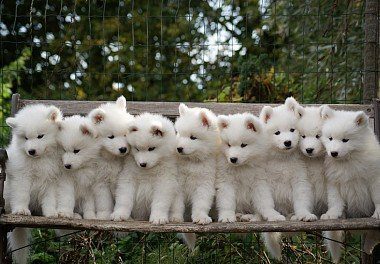
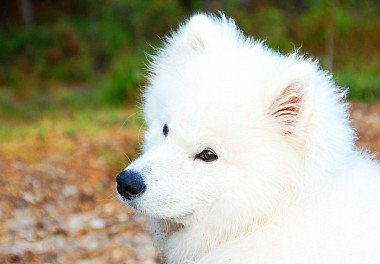
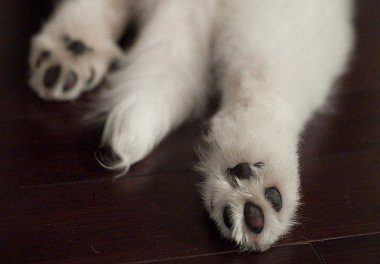
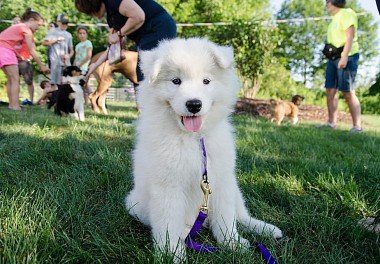
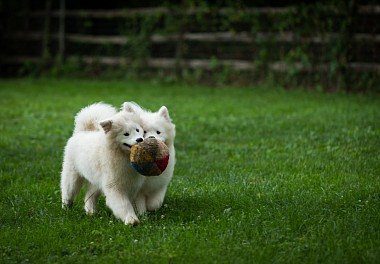
How much does a samoyed cost
The price of a Samoyed dog is quite high, which is associated with the rarity of the breed and the significant costs of breeders for breeding. In many cases, in order to maintain the purity of the breed, matings are organized abroad, which also affects the final amount.
Prices for Samoyeds range from 400-1200$, depending on the class:
- pet class. Such dogs are not allowed to breeding work due to the manifestation of certain shortcomings and defects in them. Otherwise, they are wonderful friendly pets that will be your true friends. Price – 400-500$.
- breed class. Non-champion individuals with subtle non-critical shortcomings, quite suitable for procreation. Price – 500-600$.
- show class. Elite puppy, future champion. Fully meets the breed standard. Ideal for breeding work. The price starts from 900$, sometimes it reaches 1200$. and higher. When booking a puppy in advance, the first male from the litter will be the most expensive.
An analysis of data on the cost of a Samoyed dog shows that there are no significant fluctuations in this indicator in different regions of the country.
The high price is a certain guarantee that a person who is ready to pay such a lot of money for a Samoyed will carefully and responsibly raise and maintain his pet.



